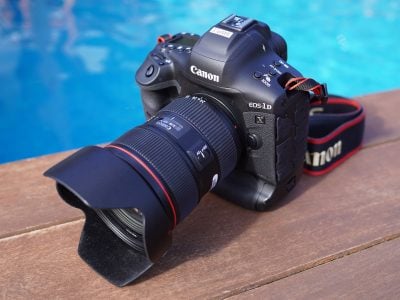Canon EOS 1Dx III review
-
-
Written by Gordon Laing
Intro
The EOS 1Dx Mark III is Canon’s flagship camera for professional sports and wildlife photographers. Teased in 2019 with an official launch in early 2020, the EOS 1Dx Mark III arrives like clockwork four years after the 1Dx Mark II, which itself followed the original 1Dx four years before that. This four year cycle is no coincidence as these bodies are designed to showcase Canon’s best technology for sports in time for each Summer Olympic games, which suggests the next model should arrive in 2024 and begs the question whether it’ll stay as a DSLR, or adopt a mirrorless or some kind of hybrid, but let’s not get ahead of ourselves. Canon reckons its best technology for pro sports photography right now remains DSLR, so here’s what it offers.
The EOS 1Dx Mark III sports a new 20.1 Megapixel full-frame sensor which Canon reckons can match 24 Megapixel rivals in detail thanks to a new low pass filter. It’ll shoot through its optical viewfinder at up to 16fps with continuous autofocus, or up to 20fps in live view with either a mechanical or electronic shutter, and both again support continuous autofocus. A new 191-point viewfinder AF system employs a CMOS sensor and deep-learning to better recognise and track subjects. The buffer, aided by a new DIGIC X processor and twin CF Express card slots, means essentially no limits whether shooting in RAW, JPEG or the new HEIF format which delivers 10-bit compressed images. It’ll film uncropped 4k up to 60p, with Dual Pixel autofocus available up to 30p, or up to 60p if you go for a cropped Cinema 4k format. There’s even C-Log and 5.5k 12-bit RAW video, recorded internally. Meanwhile the tough weather-sealed body looks almost identical to its predecessor but now features Gigabit ethernet, Wifi and Bluetooth in addition to GPS, a new Smart Controller which allows quick and precise control of the AF point, while squeezing almost 3000 shots from the same battery pack as before.
I had a chance to try out the new body for motorsports at the private Ascari race track in Southern Spain and filmed the following field test video to detail the features and share my experiences. My second video below is all about the movie capabilities of the 1Dx Mark III, this time tested with a final production body. I’ve also provided a page of sample images and a page of high ISO tests both taken with a final production body.
Ok first things first: Like all EOS 1 cameras, the 1Dx Mark III is a specialist tool designed for a specialist photographer. Some of the features may filter down to more consumer-oriented bodies in the future, but be in no doubt this is uncompromisingly aimed at the kind of person who’s job is to photograph the World Cup or Olympic Games. Indeed the EOS 1Dx Mark III arrives like clockwork four years after the 1Dx Mark II, which itself followed the original 1Dx four years before that. This four year cycle is no coincidence as these bodies are designed to showcase Canon’s best technology for sports photography in time for each Summer Olympic games, which suggests the next model should arrive in 2024 and begs the question whether it’ll stay as a DSLR, adopt mirrorless or employ some kind of hybrid technology, but let’s not get ahead of ourselves. Canon reckons its best technology for high-end sports photography right now remains DSLR, so here’s what you’ll get for the asking price of around 6500 pounds or dollars.
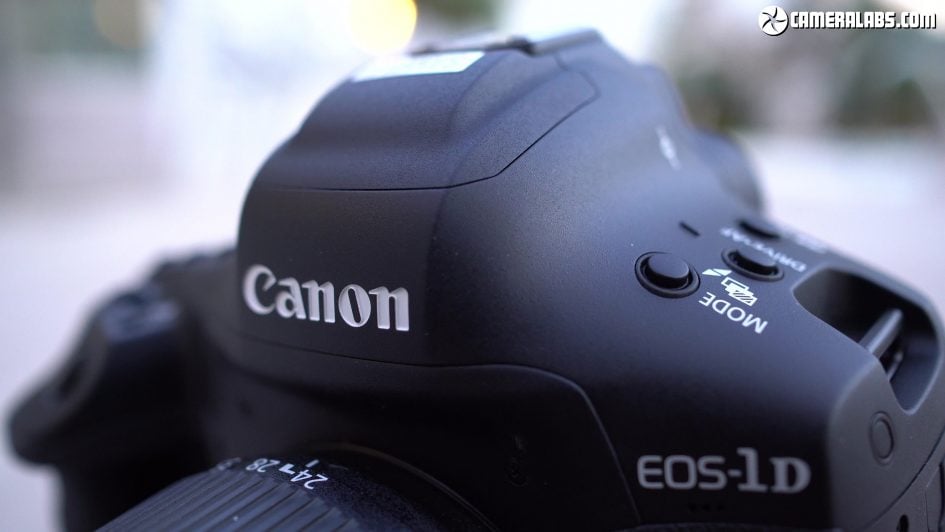
The 1Dx Mark III looks a great deal like its predecessor but features over 100 updates with Canon improving the image quality, autofocus, speed and communications. Let’s start with the headlines: With a 20.1 Megapixel full-frame sensor, the 1Dx Mark III actually shares the exact same image size as the Mark II, but it’s a new sensor with an equally new low pass filter that Canon reckons allows it to now match 24 Megapixel rivals in detail, while boasting broader dynamic range and lower noise than its predecessor. It’ll now shoot faster too: up to 16fps through the optical viewfinder or up to 20 in live view whether using an electronic or mechanical shutter – and all support continuous autofocus – yep, 20fps with continuous AF and a mechanical shutter. A new denser 191-point viewfinder AF system employs a CMOS sensor with deep-learning to better recognise and track subjects. A new DIGIC X processor with twin CF Express card slots essentially means a no-limit buffer whether shooting in RAW, JPEG or the new HEIF format which delivers 10-bit compressed images – I expect HEIF and some version of DIGIC X to filter down to future Canon bodies. It’ll film uncropped 4k up to 60p, now thankfully with sensible compression. Dual Pixel autofocus is available in 4k up to 30p, or up to 60p if you film in a cropped Cinema 4k format. There’s also the option of 10-bit C-Log or even 12-bit 5.5k RAW video, all recorded internally if desired. Meanwhile the tough weather-sealed body looks almost identical to its predecessor but now features faster Gigabit ethernet, along with Wifi and Bluetooth in addition to a dedicated GPS receiver, a new Smart Controller which allows quick and precise control of the AF point, while the camera itself squeezes almost 3000 shots from the same battery pack as before. Like most DSLRs to date, there’s no built-in stabilisation, with Canon explaining it’s not practical to implement for the optical path outside of live view. There is however electronic stabilisation for movies which I’ll show you later.
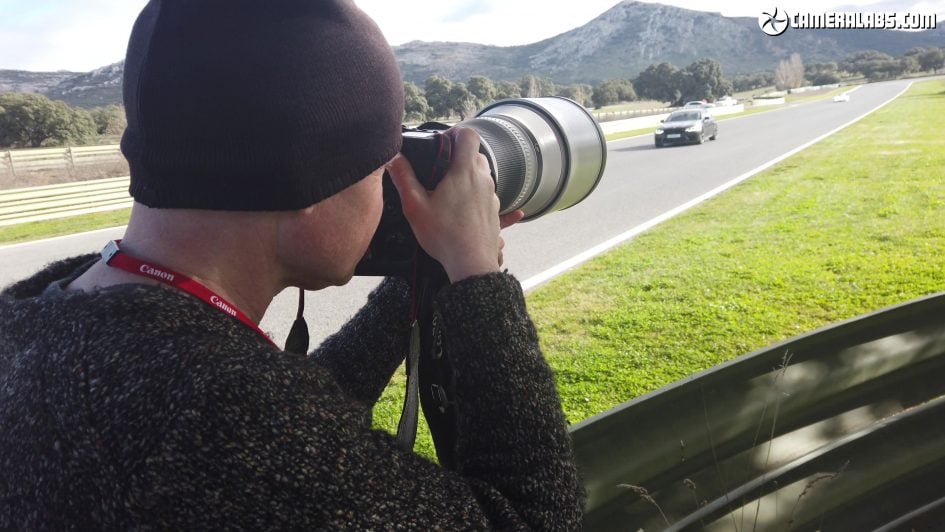
Before going any further it’s important to talk about Canon’s decision to stick with DSLR technology for a camera that’ll arguably occupy the flagship position until 2024 – and it all boils down to the speed and eye relief of the optical viewfinder and the specific job it’s aimed at. I filmed this next section through the viewfinder to show how it looks in action, adjusting the AF area and shooting 16fps bursts. Turn away from my viewfinder sequences if you’re sensitive to flickering.
Now Canon’s not opposed to electronic viewfinders for many of its cameras and styles of photography, but still believes the lag-free view through an optical viewfinder remains best for pro sports shooters working at the highest level. EVF’s can’t help but incur a tiny delay as the camera reads and processes the image from the sensor before then displaying it in the viewfinder – to be fair they’re getting quicker with every generation, but optical viewfinders still work at the speed of light and Canon told me its pro sports photographers still prefer this approach. When chatting with some of Canon’s sports ambassadors who keep one eye to the viewfinder and the other open to check out the broader scene, they also mentioned how an optical viewfinder can be less fatiguing over long periods.
Of course it’s not a one-sided argument. While Canon has reduced the viewfinder blackout on the 1Dx Mark III compared to its predecessor, Sony’s A9 avoids it altogether when shooting electronically. There’s a wealth of pros and cons to both technologies, and some of the decision between them simply boils down to personal preference, but as far as Canon’s concerned, DSLRs are still the best tool for pro sports right now. I wonder if that’ll still be the case at the 2024 Olympics?
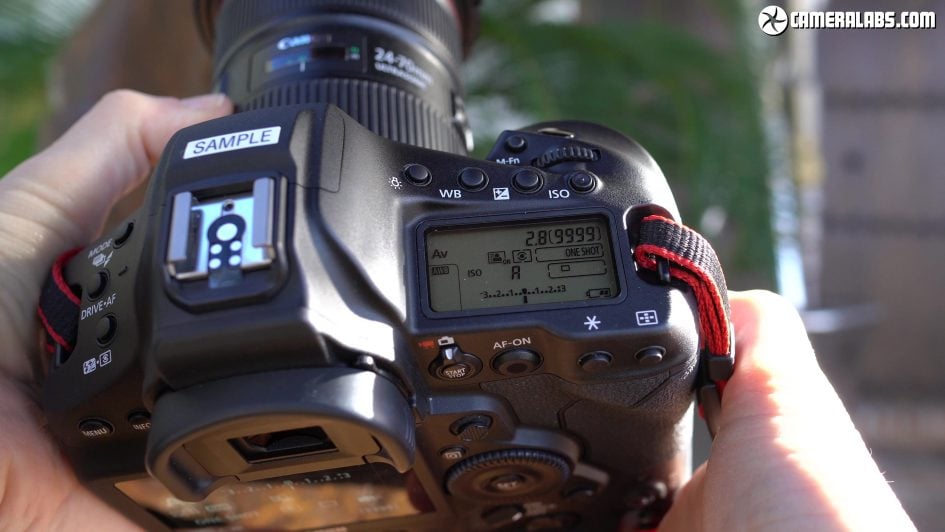
Above: Not only is the viewfinder still optical, but Canon’s been careful to ensure the overall look and feel of the Mark III remains much the same as its predecessors. Remember this is not the model where Canon should introduce radical design changes – it’s a tool for pros who need to pick it up and start shooting without delay, and they’ll feel reassuringly at home here with all the main controls where they expect them. It’s a tried and trusted design which just works.
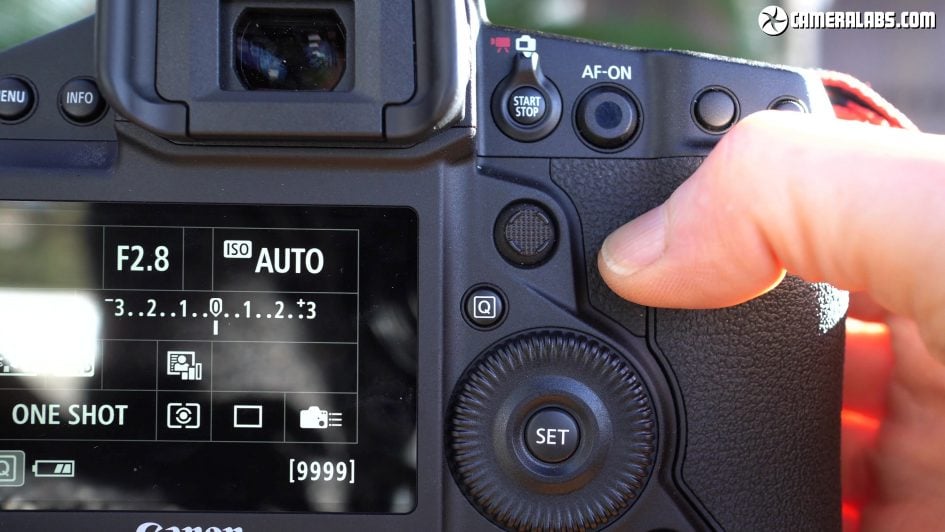
Above: That said, Canon has developed one new control for the Mark III, that manages to feel both fresh and familiar: it’s the new Smart Controller, which effectively turns the AF-ON button into an alternative way to adjust the AF area position. It uses optical technology, not dissimilar to an upside-down computer mouse, to quickly and accurately reposition the AF area by simply brushing your finger-tip over the AF-ON button. At first it sounds similar to using a screen as a touchpad, but it’s easier to reach on the Mark III’s larger body and crucially, unlike a touchscreen, works well with gloves or in the rain. In use it’s satisfyingly responsive yet precise, and quickly became my preferred means of moving the AF area, although the joystick remains available if you prefer a traditional eight-way option; both the joystick and Smart Controller are also duplicated for the portrait orientation. So unlike the divisive M-Function bar of the EOS R, I’d say the Smart Controller is a triumph, and again it complements rather than replaces familiar controls. Oh and if you push it in, it still works as an AF-ON button. I’d love to see it on future Canon bodies.
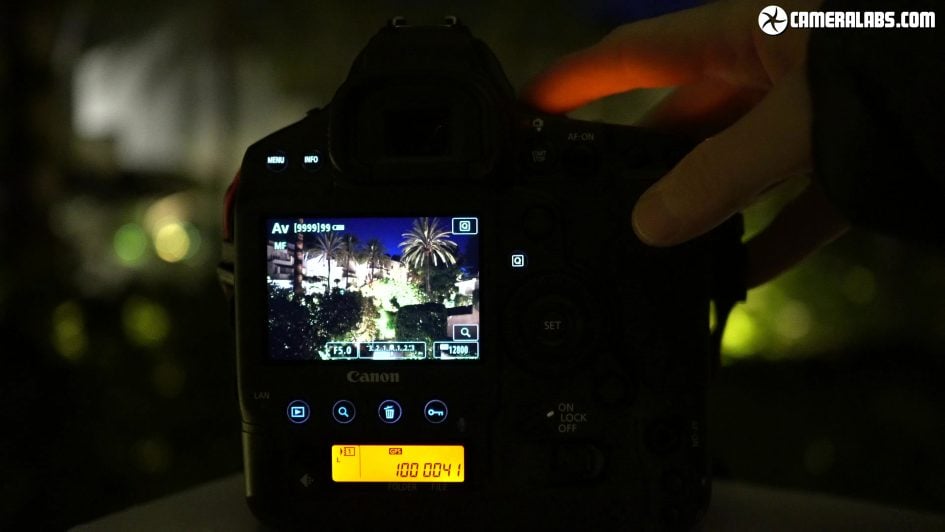
Above: Push the button to back-light the upper LCD info screen and you’ll notice a bunch of buttons on the rear now also become illuminated. It’s a feature that Nikon’s offered on a selection of models for several generations and something Panasonic also now offers on its full-frame Lumix S mirrorless bodies, but amazingly the 1Dx Mark III becomes Canon’s first body to implement backlit buttons. Better late than never.
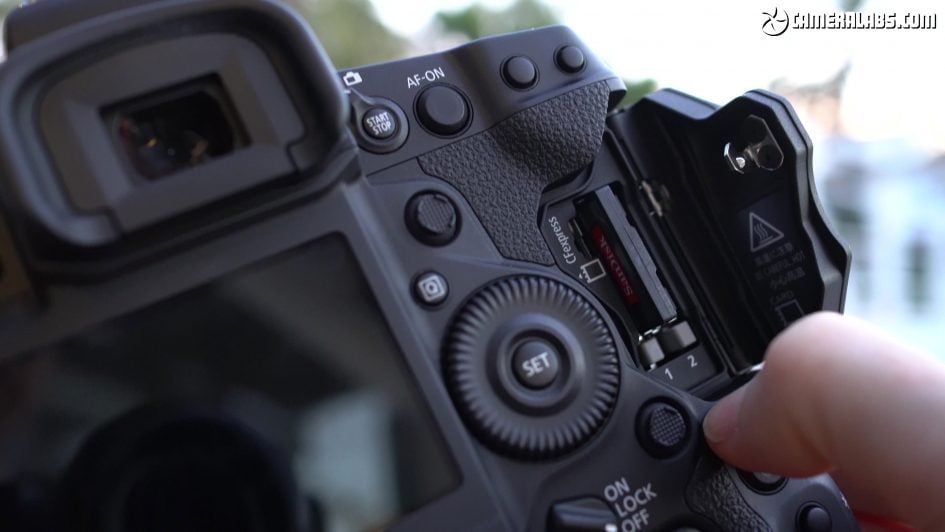
Above: Canon’s ditched the Compact Flash and C-Fast slots of the Mark II and opted for a pair of CF Express Type B slots for the Mark III. You’ll need to invest in new cards which aren’t cheap, but they’re incredibly fast and allow the Mark III to essentially shoot without limits. Canon quotes unlimited JPEG or HEIF shooting, or over 1000 RAW files, which is considerably more than the 170 RAW buffer of the Mark II.
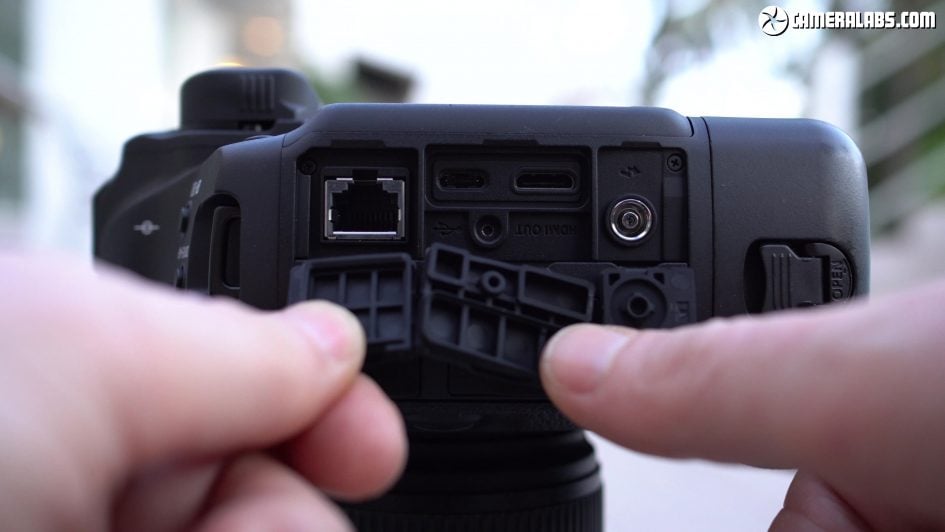
Above: Almost the entire left side is occupied by the wealth of ports with thick rubber flaps for protection. The wired ethernet has been upgraded from 100 Mbit to Gigabit and the USB to a 3.1 Gen 2 Type-C port as you’d expect, although you can’t charge or power the camera over USB, and oddly considering the size of the camera, Canon’s stuck with Mini rather than full-size HDMI. Meanwhile alongside the microphone and headphone jacks is an N3 remote terminal and a dedicated port to connect the optional WFT-E9B accessory to extend wireless performance.
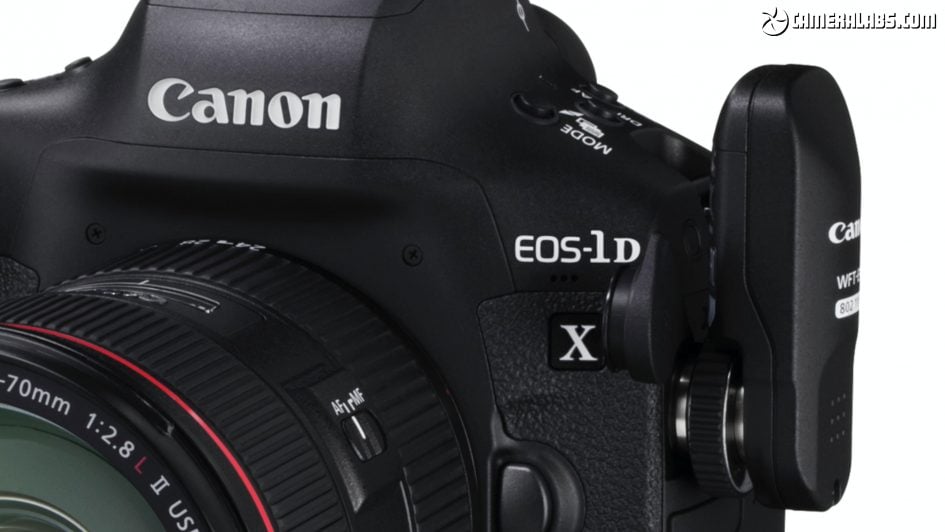
Above: In a handy upgrade over the Mark II, Canon’s now equipped the Mark III with built-in Wifi and Bluetooth, in addition to the dedicated GPS receiver. Wifi was left out on earlier models as the range from a built-in system – especially within a tough body – wouldn’t be sufficient for wireless connectivity in a stadium environment, but Canon’s realised it’s still useful for closer-range communications, such as with your phone. As before though, you should fit the WFT accessory for the fastest speed and longest range. Canon’s also developing secure browser-based remote control over https including live view. Canon also talked about future cloud processing of RAW files delivering superior noise reduction capabilities.
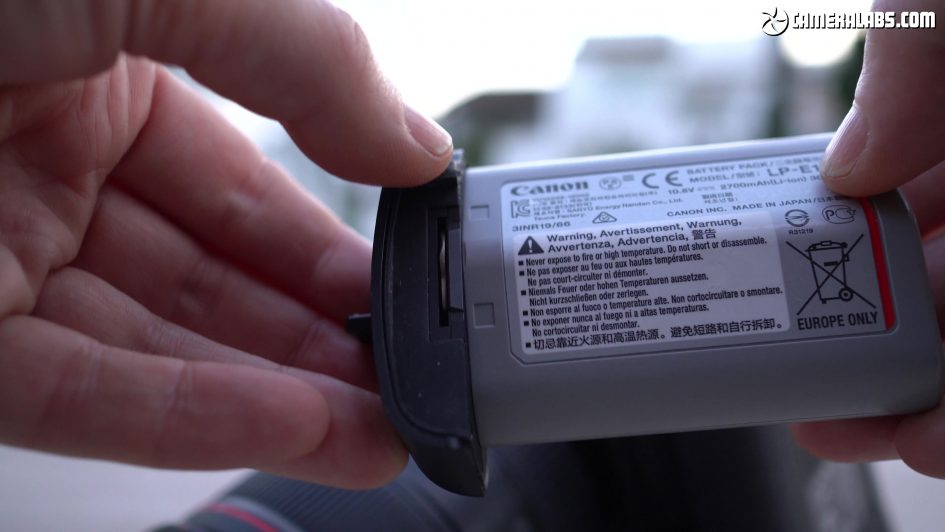
Above: The Mark III employs the same LP-E19 battery pack as before, but now squeezes greater life from it, with Canon quoting almost 3000 shots per charge. The life of course varies with use, but during my time with the Mark III shooting long fast bursts, I achieved well over 3000 shots.
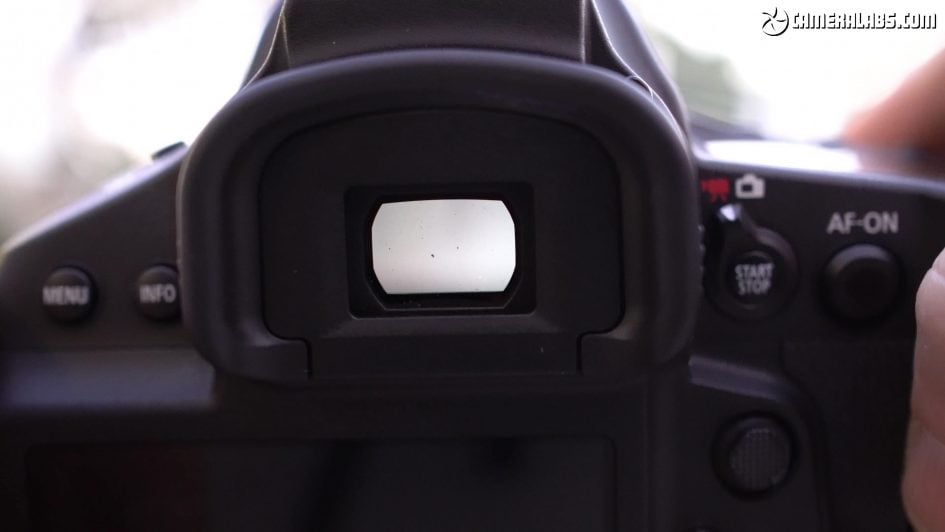
Above: As a traditional DSLR, the Mark III employs an optical viewfinder with the same 0.76x magnification and 100% coverage of its predecessor. Again Canon reckons the absence of delay with optical viewfinders remains preferable for pro sports shooters even though there’s some blackout – albeit now reduced – between frames. When shooting through the optical viewfinder, the Mark III features a top burst speed of 16fps with continuous autofocus, a boost over the 14 of the Mark II, and an impressive mechanical achievement. The earlier Mark II could manage 16fps, but only in Live View and without AF.
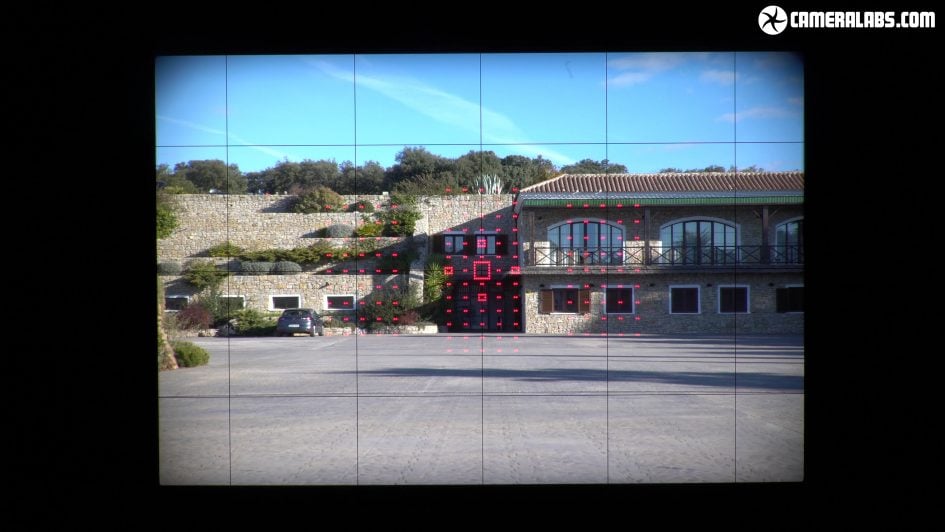
Above: More importantly the viewfinder now employs a new 191-point autofocus system with 155 cross-type sensors versus the 61-point system of the Mark II, of which 41 were cross-type. This allows the Mark III to trump both its predecessor and the older Nikon D5, but the interesting part is the technology behind it. Rather than employ a dedicated AF sensor with fixed AF points, the Mark III uses a separate high resolution CMOS imaging sensor with its own dedicated DIGIC 8 processor. In theory this could allow a denser or even reconfigurable array, but Canon told me the number and type of AF points were optimised for performance, while the traditional coverage and shape of the array was actually limited by the optical path of a DSLR. Meanwhile, the high resolution of the sensor suggests it could be used for face or even eye-detection through the viewfinder, but as a monochrome sensor without any colour capabilities, face detection remains more effectively performed by the colour-capable metering sensor instead.
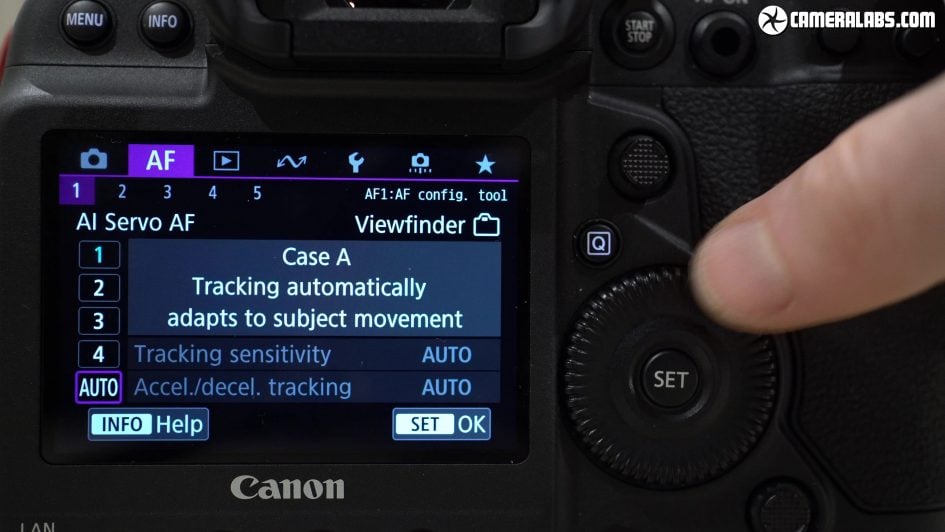
Above: The autofocus options appear on the surface to be the same as before, apart from the addition of a new option which automatically chooses the best case, but behind the scenes Canon’s revamped the entire system with Deep Learning which aims to better-identify and track subjects. Unlike AI, Deep Learning doesn’t mean the camera adapts and evolves as you use it – the learning part took place while Canon was programming the AF system – but in use it really does seem to identify the human subject which in the case of motor racing I tried it with, was often behind a helmet and sat in the middle of the vehicle. Now in terms of action I’ve only had the chance to try it with motor racing so far, but it’s still a tougher test than athletics and a great start for the camera.
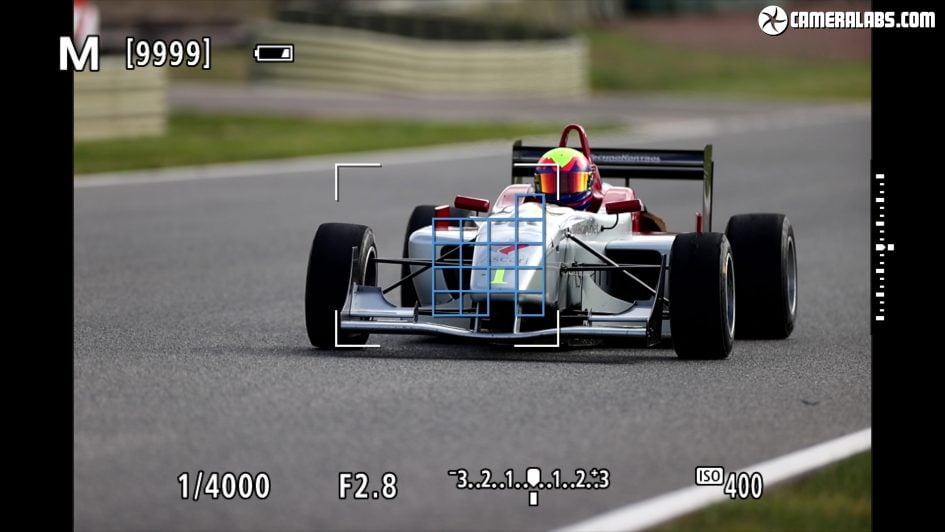
Above: Moving onto the screen, Canon’s stuck with a 3.2in sized display, although now with a panel using 2.1 versus 1.6 million dots. In Live View, the Mark III employs Dual Pixel autofocus across almost the entire frame with a variety of focussing areas including spot, expand and zoned modes; you can easily reposition the AF area by touch, using the joystick or the new smart controller. Human face and eye detection is also available, although Canon’s resisted implementing animal eye AF which could give Sony an advantage for wildlife photographers. With the mirror locked-up in Live View, the Mark III can now shoot even faster than with the viewfinder – up to 20fps whether using a silent electronic shutter or a proper mechanical shutter, and both support continuous AF. That’s impressive stuff: 20fps with autofocus using a mechanical shutter – most rivals only allow this kind of speed with an electronic shutter. I tried shooting the race cars in Live View and found the system did a fair job, albeit not quite as confident or quick to initially respond as shooting through the viewfinder. The longer baseline of the phase-detect points in the viewfinder AF system are simply more effective and accurate than Dual Pixel AF at longer focal lengths, especially when the subject’s initially blurred – for example when first entering the frame. That said, the Mark III in Live View still delivered a respectable hit rate with the cars, while enjoying broader coverage and supporting face and eye detection – plus with 20fps you’ll have plenty of images to pick from. Dual Pixel is certainly an effective alternative for other types of subjects, and of course drives the movie autofocus.
Now let’s take a look at the image quality from the new sensor. As you know, the actual images from the Mark III contain the same number of pixels as the earlier Mark II, but Canon claims the images now contain more detail due to an improved low pass filter, and that there’s also lower noise and broader dynamic range.
One of the most interesting aspects though is the adoption of the High Efficiency Image Format, HEIF, or HIF for short. This is a modern alternative to JPEG which employs the more efficient compression of HEVC video to deliver better-looking images with smaller file sizes, and with the possibility of higher dynamic range too. Apple introduced it to the mainstream on recent iPhones, but Canon’s the first traditional camera company to offer it. In theory it’s a no-brainer, but it’s still early days for the format and your software may not support it yet, so bear that in mind if you want to edit or share HIF images.
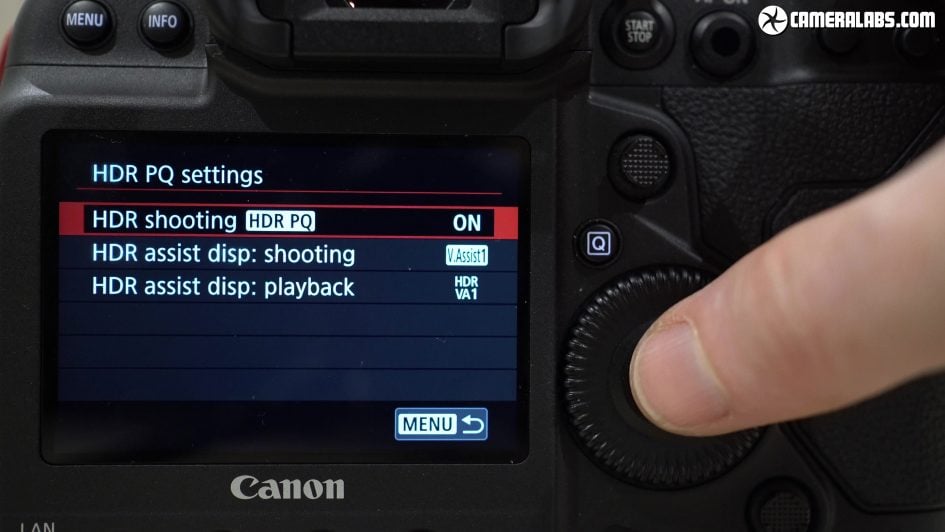
Above: I’m going to jump right into Canon’s approach as there’s already loads of backgrounders on HEIF history and tech. On the 1Dx Mark III, you have to choose whether the camera records JPEG or HEIF – you can’t record both at the same time, although whatever you choose can also be recorded with an additional RAW file if desired. Rather than offer a simple menu where you can tick JPEG or HEIF though, Canon forces you to the slightly confusingly titled HDR PQ menu instead. This is where you can enable HEIF instead of JPEG as your compressed format of choice, as well as whether to prioritise mid or highlight tones in the processing. Once enabled, it effectively replaces JPEG in the other menus as your compressed format, but you can switch back and forth whenever you like.
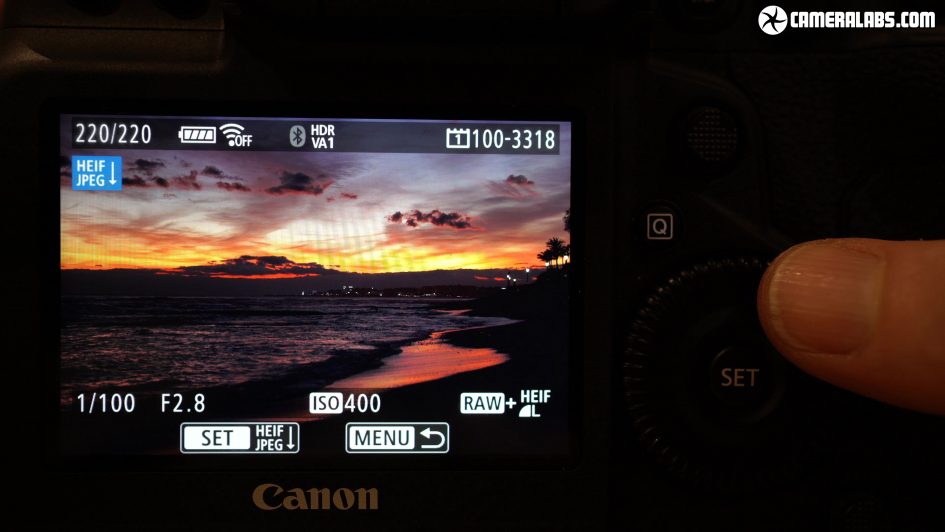
Above: On the 1Dx III, Canon’s using the HIF file extension for this format and It’s also possible to convert them into JPEGs using the camera in playback, which in theory could generate an image with a broader or at least alternatively tone-mapped dynamic range than a native JPEG created at the time of capture. This forms the basis of my next comparisons, although when converting them one at a time using the camera, I did yearn for a batch conversion option.
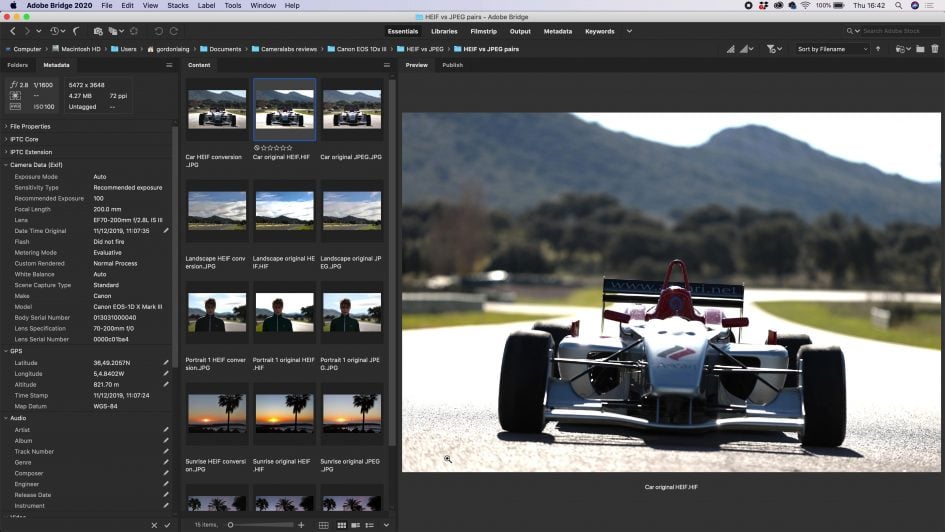
Above: To compare JPEG and HEIF, I took two photos of the same subject moments apart using each format. I then converted the HEIF file into a new JPEG using the camera’s playback menu for comparison here, as Final Cut couldn’t directly import the HEIF files at the time I made this video. At this point even some of the applications that could recognise HEIF as an image format often displayed them with strange tone mapping. You can see Adobe Bridge here previewing the HEIF originals with crushed highlights, while Photoshop wouldn’t even open them unless I changed their file extension from H.I.F to H.E.I.F or H.E.I.C. Obviously this is likely get better as more cameras support HEIF and the format becomes more established, but right now for this comparison, the most effective approach was to compare out-of-camera JPEGs against JPEGs generated from a HEIF file using the camera’s menus. Since the original HEIF files on the 1Dx Mark III have 10 bits of tonal range compared to 8 on a standard JPEG, it allows the camera to handle that broader range differently at the time of conversion, possibly retaining greater highlight or shadow detail. Before showing you the results, Canon asked me to say these images were shot on pre-production Canon beta sample models, final image quality may vary.

Above: Here’s my first image of a parked race car, and on the left is the original JPEG out of camera, while on the right is the JPEG generated from the HEIF file. You’ll notice the converted HEIF file has retained more highlight and mid-tones, best-seen on the reflective road surface and the background scenery. Interestingly I noticed the 1Dx III often metered a shutter speed one third of an EV slower when set to HEIF, so in this instance, the HEIF file was captured at 1/1600 versus 1/2000 for the JPEG. This was also the case for compositions which matched more closely than this one.

Above: My second image shows a landscape with wispy clouds. On the left is the original JPEG out of camera, while on the right is the JPEG generated from the HEIF file, and again the 1Dx III metered a slightly slower exposure of 1/320 for the HEIF vs 1/400 for the JPEG here. As I alternate between them you can see the converted HEIF file has retrieved some highlight cloud detail that’s mostly blown-out on the original JPEG.

Above: In my third example I’ve gone for a portrait shot which, using the camera’s viewfinder metering, has under-exposed the subject a little in my opinion; again though, the HEIF exposure remained one third of an EV slower. On the left is the original JPEG out of camera, while on the right is the JPEG generated from the HEIF file. The initial differences are more subtle than before. There’s not any obvious difference in the clouds, although the road surface is a little less saturated. Interestingly the biggest difference – to my eyes anyway – is actually the impact on the blurred transitions in the distance. Look closely at the mountain ridge and the edges of the trees on the right and you’ll see the HEIF version actually shows a more sudden transition with the sky, almost like a stripe or band, which doesn’t look as good as the smoother transition on the JPEG version to me eyes. This goes against what I expected from the higher dynamic range of the HEIF original, although remember we are comparing JPEGs here.

Above: In the fourth example I have a sunrise for you and again the biggest difference between the original JPEG on the left and the converted HEIF file on the right regards the gradation between the saturated solar disc and the sky around it. The converted HEIF file blends to an orange colour sooner than the JPEG, but is it correct or more desirable? At this point I’d also like to make another observation: HEIF often promises the quality of a JPEG with roughly half the file size, but of course the actual file sizes depends on the level of compression employed by the camera. When using the default settings on the 1Dx III, I found my original HEIF files were indeed smaller than the original JPEGs, but only by about 10% in these examples. Oh and in terms of exposure, the camera broke its habit so far and actually metered one third of an EV faster on the HEIF version here.
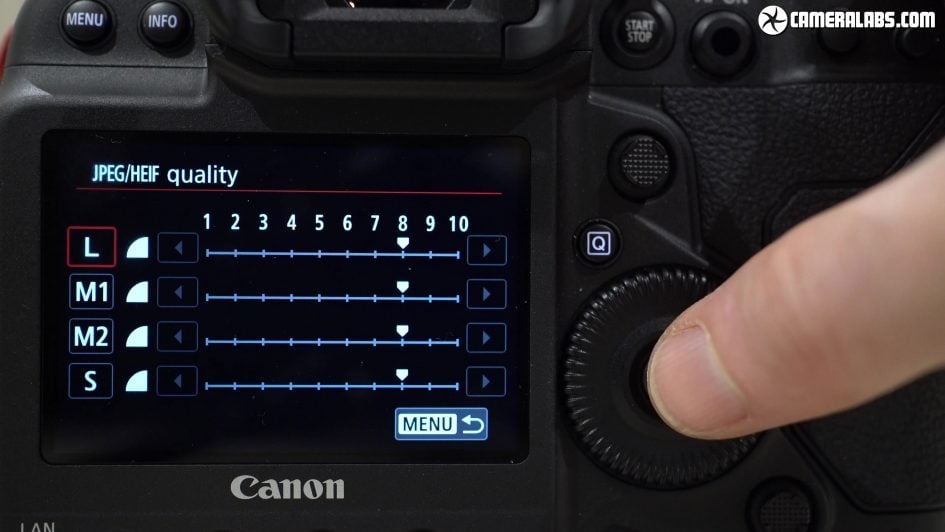
The degree of compression is very finely adjustable on the 1Dx III though so there’s plenty of opportunity to tweak.

Above: Now for my fifth and final example, this time of the dusky sky following sunset and this time the 1Dx III metered the exact same exposure for both files. on the left is the original JPEG out of camera, while on the right is the JPEG generated from the HEIF file. The biggest difference is the brightness and colour of the main sky area, which looks less intense as a result. Which versions of the five examples I’ve shown you are your favourites?
Technically speaking HEIF should be a no-brainer as the compressed format to replace the ageing JPEG. They’re smaller, have the potential to contain a broader dynamic range and may also be able to accommodate some simple non-destructive edits like rotations. As I discovered in this brief test though, the real potential for HEIF is greatly dependent on what software is working with them. At the time of writing, I couldn’t natively work with Canon’s HEIF files in my photo or video workflow, so I had to use the 1Dx III’s built-in converter to generate JPEGs for comparison. As such this first test is really more about comparing two different ways a camera – and a pre-production one at that – can generate a JPEG image which obviously won’t show the full benefits of HEIF beyond tone-mapping it differently to an 8-bit format.
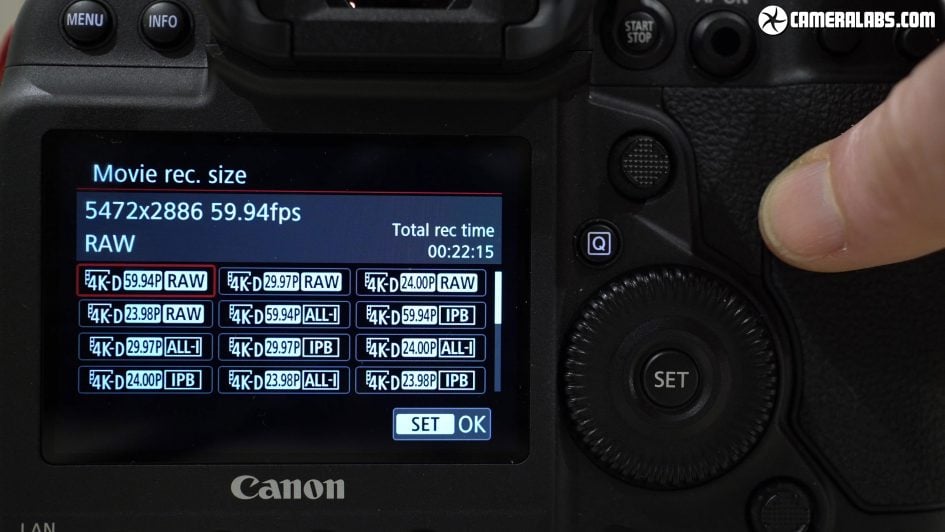
Above: Now for movies. The earlier Mark II was one of the first to offer 4k at 60p, but with a tight crop and inefficient Motion JPEG compression. Now the Mark III can film uncropped 4k up to 60p (or 30p if you want autofocus) with the much more sensible H-264 compression or in 10-bit H.265 if you enable C-Log for later grading. You can also film in the wider Cinema 4k shape in uncropped or cropped formats up to 60p, and most options are available in the choice of IPB or All-i compression and for clips up to half an hour. Impressively the 1Dx Mark III also allows you to record RAW video in 12 bit at 5.5k resolution – that’s 5472×2886 pixels, which offers a noticeable boost over the 3840×2160 pixels of 4k UHD, although at understandably hefty bit rates typically working between 1800 and 2600Mbit/s depending on frame rate. These are stored in CRM files. Dual Pixel autofocus is available for uncropped 4k between 24 and 30p, and is also available for uncropped Cinema 4k and RAW 5.5k so long as you stick at 24 to 30p. Sadly at 50 or 60p, Dual Pixel autofocus is not available in any of the uncropped 4k, Cinema 4k or RAW formats, but there’s one workaround: switch to the cropped Cinema 4k format and Dual Pixel autofocus becomes available all the way up to 60p. It’s just the uncropped 4k or RAW formats which don’t support autofocus above 30p. If you’re into slow motion, the 1Dx III can film 1080 up to 100p for PAL regions or 120p for NTSC regions for quarter-speed playback. Considering some cameras already offer 180fps, I was hoping for something at least as fast from the 1Dx III. There’s examples of all the movie modes in my video field test at the top of the page, plus some more below.
Above: Download the original file (Registered members of Vimeo only). I also have a version filmed in 1080p: Canon EOS 1Dx Mark III 1080p movie sample.
Above: Download the original file (Registered members of Vimeo only).
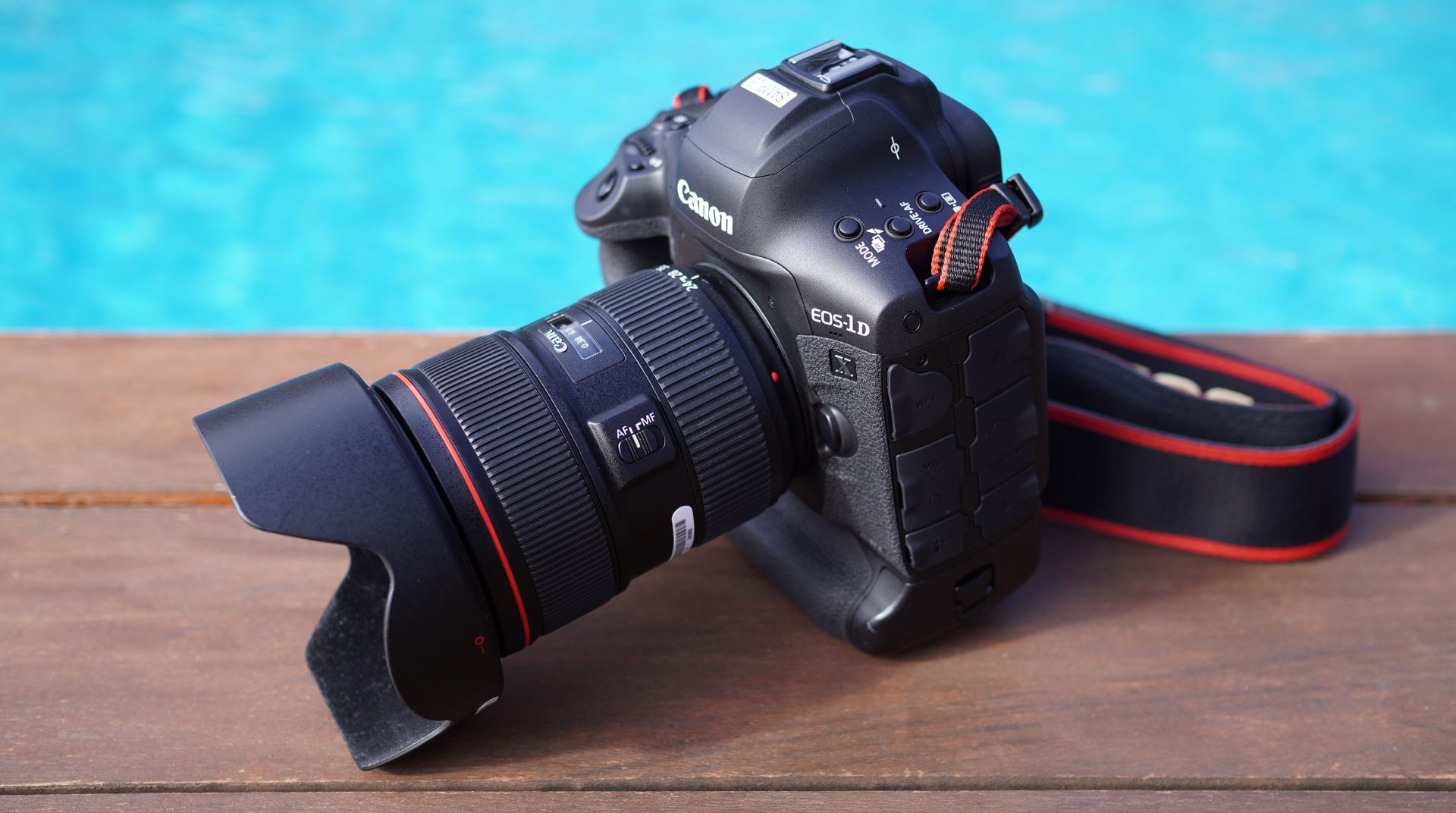
 I've now spent some time with the 1Dx Mark III, from a Canon field test in Spain to my own independent tests with a final production model later, and what I’ve seen so far is very impressive. Canon’s packed in a wealth of important upgrades crucially without getting in the way of the handling experience that pros have become familiar with. Owners of previous models can pick up the Mark III and just start shooting without skipping a beat. Of the new features, I was fascinated by the use of an imaging sensor for viewfinder autofocus duties. It makes a lot of sense, and driven by Deep Learning it did a great job at recognising and tracking people in often complex scenes. Coupled with the faster burst speeds, DIGIC X processing and swift card writing, this is a camera that effortlessly handles action at the highest level - as it should. I was also fond of the new Smart Controller which quickly allows you to reposition the AF area, and it’s a relief to finally find a camera company offer an alternative to JPEG for compressed images, with the HEIF format having a lot of potential. In terms of video, the 1Dx Mark III also becomes Canon's most capable model below the Cinema series, making it an extremely flexible camera for stills and movies. Arguably the most controversial aspect is that it’s still a traditional DSLR, but Canon firmly believes this is still its best technology for the very specific requirements of demanding pro sports photographers.
I've now spent some time with the 1Dx Mark III, from a Canon field test in Spain to my own independent tests with a final production model later, and what I’ve seen so far is very impressive. Canon’s packed in a wealth of important upgrades crucially without getting in the way of the handling experience that pros have become familiar with. Owners of previous models can pick up the Mark III and just start shooting without skipping a beat. Of the new features, I was fascinated by the use of an imaging sensor for viewfinder autofocus duties. It makes a lot of sense, and driven by Deep Learning it did a great job at recognising and tracking people in often complex scenes. Coupled with the faster burst speeds, DIGIC X processing and swift card writing, this is a camera that effortlessly handles action at the highest level - as it should. I was also fond of the new Smart Controller which quickly allows you to reposition the AF area, and it’s a relief to finally find a camera company offer an alternative to JPEG for compressed images, with the HEIF format having a lot of potential. In terms of video, the 1Dx Mark III also becomes Canon's most capable model below the Cinema series, making it an extremely flexible camera for stills and movies. Arguably the most controversial aspect is that it’s still a traditional DSLR, but Canon firmly believes this is still its best technology for the very specific requirements of demanding pro sports photographers.



